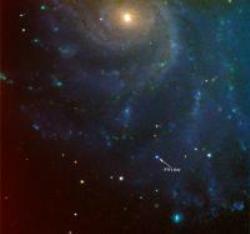A supernova was spotted on Wednesday by scientists at UC Santa Barbara (UCSB), which was closer to the Earth than any other supernovae discovered, at a distance of about 21 million light years. The supernova was observed few hours before it actually exploded, which happens very rarely especially as far as events of this type are considered.
The identification of a supernova in the beginning of its life, nearby to Earth has kindled interest in scientists in the astronomical field. Scientists are rushing to study it with different telescopes such as telescopes from the UCSB-affiliated Las Cumbres Observatory Global Telescope Network (LCOGT) and the Hubble Space Telescope.
 supernova
supernova
Andy Howell, staff scientist at LCOGT and adjunct professor of physics at UCSB, is one of the persons who headed the team that identified the supernova.
The Palomar Transient Factory (PTF) survey, conducted to study and disclose the astronomical events as soon as they occur, discovered the supernova. The supernova has been named PTF 11kly, took place in the Ursa Major or Big Dipper constellation in the Pinwheel Galaxy.
According to Howell, the supernovae brightness exceeds a billion suns during the initial three weeks post the explosion, since high-power radioactive elements are emitted that decompose and produce light. Generally they cannot be seen immediately after the explosion, for they are dim, but it has been possible this time since the event occurred at close proximity and since robotic telescopes were used. The PTF survey utilizes automated telescopes to examine the night sky and notify scientists in case any changes are identified. Further research is then conducted using the robotic telescopes at LCOGT.
The team urgently requested the use of the Hubble Space Telescope to observe the supernova. The roster of the telescope was fixed weeks before, but was modified to observe the novel supernova regularly from Saturday. This will help the team to study about the chemistry and physics of the process.
The scientists in the PTF have identified more than 1,000 supernovae since it started functioning in 2008, and this is one of their most spectacular discoveries.